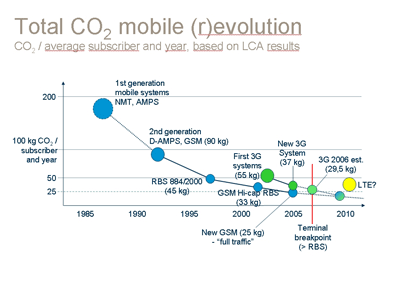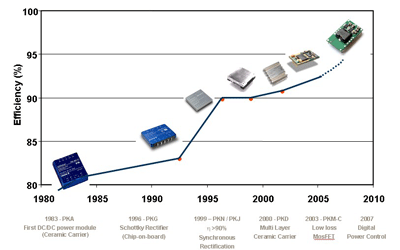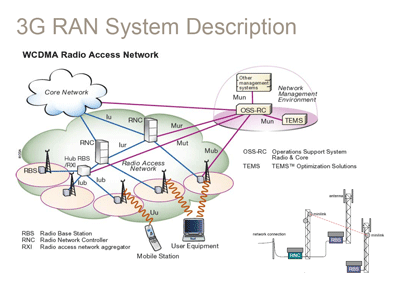The effect of digital power on mobile comm emissions
The addition of a standby function during low-load and digital control circuits can save a million tons or more of CO2 per year
BY PATRICK LE FÈVRE
Ericsson Power Modules
Plano, TX
http://www.ericsson.com/powermodules
The rapid development of global communications and new technologies contribute, to an extent, to global warming, according to a recent Gartner Symposium entitled ‘ITxpo 2007 Emerging Trends’. The analysts said that the global ICT industry accounts for approximately 2% of global CO2 emissions – a figure that is equivalent to the aviation industry emissions, according to Gartner. This number is an estimate, but ICT is a huge area with many applications that includes power-hungry data centers and Wi-Fi hotspots. All these applications perform differently when it comes to energy efficiency and levels of energy savings attained.
Among all the different applications included under the banner of ICT, there is one that merits consideration as an example and case-study for the next step of implementing digital power management versus existing analog control — mobile radio and radio base-station applications.
Mobile radio growth
In 50-plus years, the mobile phone industry grew extremely rapidly and, according to the global trade association GSM association, the number of subscribers around the world is set to increase by 40 million per month (!) during 2007. In May 2007, Ericsson announced that the one millionth radio base station was shipped to a customer, and Powerwave announced that they deployed more than 1.3 million tower-mounted amplifiers for hundreds of cellular, PCS, GSM, and 3G networks around the globe. Both announcements reflect the volume of equipment making mobile communication possible, and with the growing demand for long and midrange mobile-communication systems such as GSM, 3G, and Femto-cells, it is easy to see that the amount of energy consumed by the aggregated number of equipment deployed all over the world will continue to grow, requiring a number of measures to limit their environmental impacts.
Radio base station good but . . .
Compared to other industries the pure telecom industry has relatively low CO2 emissions, and Ericsson estimates that the industry is responsible for 0.4% of global primary energy consumption and 0.3% of CO2 equivalent emissions. Out of this number, assuming 2.6 billion subscribers, it is estimated that the mobile telecom’s CO2 equivalent represents just 0.09%.
Looking at the evolution of energy consumed by mobile radio, and CO2 emissions (see Fig. 1 ), it is clear that since the introduction of the first generation of mobile systems, energy efficiency has improved while performance and capacity have increased. However, experts agree that the environmental impact must be further decreased.

Fig. 1. Total CO2 emissions for mobile systems.
CO2 emission occurs when the networks are in operation. These are the parts where digital power and digital power management could contribute to further reduce CO2 emissions while improving system efficiency.
Power efficiency in the mobile radio
The result of many different measures and technical innovations, as shown in Fig. 1, the level of CO2 emission reduced throughout the years follows a general improvement in dc/dc converters efficiency (see Fig. 2 ).

Fig. 2. The efficiency of dc/dc converters has increased in the last 25 years.
Driven by new components and innovative topologies, over two decades the power industry has managed to drastically improve the power efficiency of dc/dc converters and dc/dc regulators, reaching an upper limit that becomes more and more challenging to surpass! Components and technologies will continue to improve for sure, but recent examples from by the micro-processor industry have proven that energy and data-management can be optimized even more to increase performance while reducing energy consumption (e.g., using multicore processors instead of single core, PMOS technology, sleep transistors, etc.)
As presented by Pierre Gilbert at APEC 2006, different parts of a radio system have great room for improvement in energy management terms, and without disclosing advanced research on the radio transmission part, it is evident that performance improvements will not only depend on natural components’ evolution but more on a combination of different technologies such as digital power management associated to new components (e.g., silicon carbide).
Telecom systems are very dependant on traffic and inter-operation between the different cells (see Fig. 3 ). Besides software managing the split between cells and allocation, the state of the art will be to manage at signal processor level, the energy consumption in real time, and to predict in advance what the energy system might require before requested by traffic (i.e., using pro-active energy management).

Fig. 3. The dependency of telcom systems on traffic and cell interoperation.
As it is for portable and nomadic equipment, reaching the optimal energy-efficiency-management will require managing energy by function at the board level. Based on today’s analog solution this is very complex, requiring multiple interfaces making things difficult to work together and to communicate with the rest of the system.
Before implementing intelligence in power conversion and power management at the system level, it is important to decide on a common language, that is freely available, and that everyone understands. That was the first task undertaken by the electronics industry, which was successfully conducted under the PMBus initiative. The result was a standardized protocol adopted by most of industry leaders such as Intel, Dell and others.
In parallel the product dimensions should be considered as well as how to convert analog dc/dc converters and dc/dc regulators into units that work with or respond to a digital signal without adding extra interfaces and cost. This step is now partially complete and different papers presented by Ericsson at DPF, APEC, and PCIM demonstrated that the migration from analog to digital power management is technically possible and the implementation of the standardized communication PMBus is a reality. From these points you might ask, “how will such technology help telecom manufacturers and operators operate their systems in a more efficient way, resulting in less power consumption and lower CO2 emission?”
When digital power becomes a reality
Often, we only consider the core processor as being the component requiring tight control. But, if that is a very important part of the system, such components are relatively easy to control because they are already digital.
For some time, the voltage regulator module (VRM) and the voltage regulator down (VRD) have been able to communicate with the processor, so digital control is virtually there. By adopting PMBus, Intel has given a clear signal that future products will easily be able to communicate with their neighborhood.
As mentioned, power consumption in mobile radio applications is very much driven by traffic, and by combining traffic management and intelligent power-management it will be possible to power only the required part of the system needed at that time and to standby the rest of the time. Otherwise, when traffic increases the traffic management controller will enable additional functionalities.
For example traffic management could control the number of power amplifiers in operation and decide to power on or off some of them when traffic increases or decreases, or to adjust the polarization voltage to the most efficient profile at time.
At cabinet level, certain boards that include mixed functionalities that are only required at a certain times during the operation will have the ability to be powered on/off, or adjusted to suit vital parameters, and precisely monitored to make it possible for the traffic management controller to report in real-time to the site manager on different parameters.
Managing power management down to the vital few is also very important to reduce the fixed operational power and especially the power consumed by air-conditioning and ventilation. On average, 30% of the power consumed in a radio base station is for cooling.
Adding digital control to individual boards and PMBus, it becomes simpler to better control cooling and ventilation, optimizing operational conditions to suit specific traffic conditions, and statistically profile the power demand for the requirements of the next flow of traffic.
If considered at the start of the project, the same type of topology could easily be deployed to fix access and other ICT applications such as datacenters, reducing power consumption and CO2 emission.
For more on power management, visit http://electronicproducts-com-develop.go-vip.net/linear.asp.
Advertisement
Learn more about Ericsson Power Modules





